Experienced Care of Congenital Hand Conditions in North Austin
The hand and upper extremity surgery team at Texas Children's Hospital North Austin Campus has the skill, experience, and resources to provide comprehensive, interdisciplinary care for infants, children, and adolescents. Our experts are trained in adult and pediatric hand and upper extremity surgery, plastic surgery, and reconstructive microsurgery and are committed to caring for children with congenital hand and upper extremity differences.
There are many types of congenital hand conditions. Some children have too many or too few fingers, some have fingers that move less or move differently, some have fingers that are joined together, and others have fingers that are shaped differently.
Congenital hand differences can occur alone or along with problems in other body systems such as the head and face, bones and muscles, heart, blood, brain, or spine. In particular, some children with complex craniofacial syndromes also have congenital differences of the hand and upper extremity. This combination of differences is due to timing of development of the face and upper extremities in the womb. Apert syndrome, Saethre-Chotzen syndrome, Pfeiffer syndrome, and Carpenter syndrome are the most common congenital craniofacial syndromes that also have hand and upper extremity differences. Hand differences in these syndromes are often a combination of different appearing fingers or thumbs – either fused, stiff, curved, wide and/or duplicated. Some children also have limitations in forearm or elbow motion due to fusion of the forearm bones.
Hand surgery focuses on helping your child use his/her hands in the best possible way while also upholding the appearance of the hand. We specialize in treating children at various stages of development and tailor care to meet your child’s specific needs. We will care for your child as he/she grows and develops, and we will support your family every step of the way.
- Syndactyly is when some of the fingers are webbed or joined.
- Any fingers can be involved. Most commonly, the middle and ring fingers are joined.
- Sometimes syndactyly runs in families or is part of another medical condition or syndrome.
- There are many types of syndactyly. Sometimes only the skin is fused but other times various amounts of bones and tendons can be fused or shared.
- Syndactyly is treated with surgery to separate the joined fingers. Surgery is usually performed around 1-2 years of age. Skin grafts from another part of the body are often needed to close the skin along the separated edges. When multiple fingers are joined, multiple surgeries are usually needed to safely and fully separate the fingers. Your child will be in a cast while his/her hand heals. Once the cast is removed, hand therapy and scar treatment begin.

Hand differences in Apert Syndrome
- Children with Apert Syndrome have a unique type of syndactyly.
- Syndactyly in Apert syndrome is more severe than syndactyly in children without Apert syndrome. Among children with Apert syndrome, there is a spectrum of hand differences – sometimes the thumb is tethered and sometimes the fingers are tethered so tightly that the hand seems to close on itself.
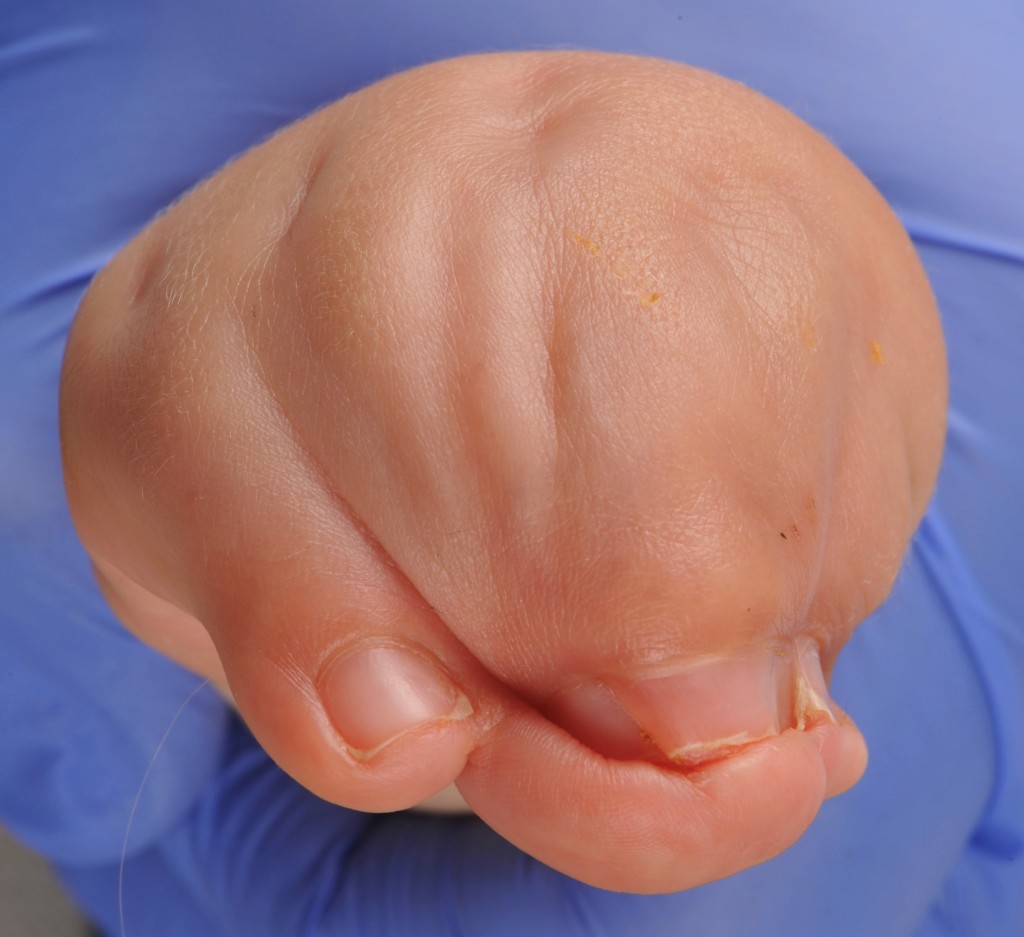
In this child with Apert syndrome, his thumb and all of his fingers are tightly joined.
- In addition to sharing skin and bones, the fingers also have stiff joints and less flexible fingers, also known as “symphalangism”. Even after separation, the fingers will still have less motion.
- In addition, Apert thumbs are usually short, curved, and stiff.
- It is not safe to separate all the fingers at once. Rather, multiple surgeries are needed to safely separate the fingers. Because the timeline for treating the hands overlaps with the timeline for craniofacial surgery, in some cases hand surgeries can be combined with another scheduled surgery.
- The initial hand surgeries separate the skin and bones and apply skin grafts to the open areas. Later, hand surgery might be recommended to broaden the space between the thumb and index finger and/or to straighten and lengthen the thumb. Your child will be in a cast after surgery while their hand heals.
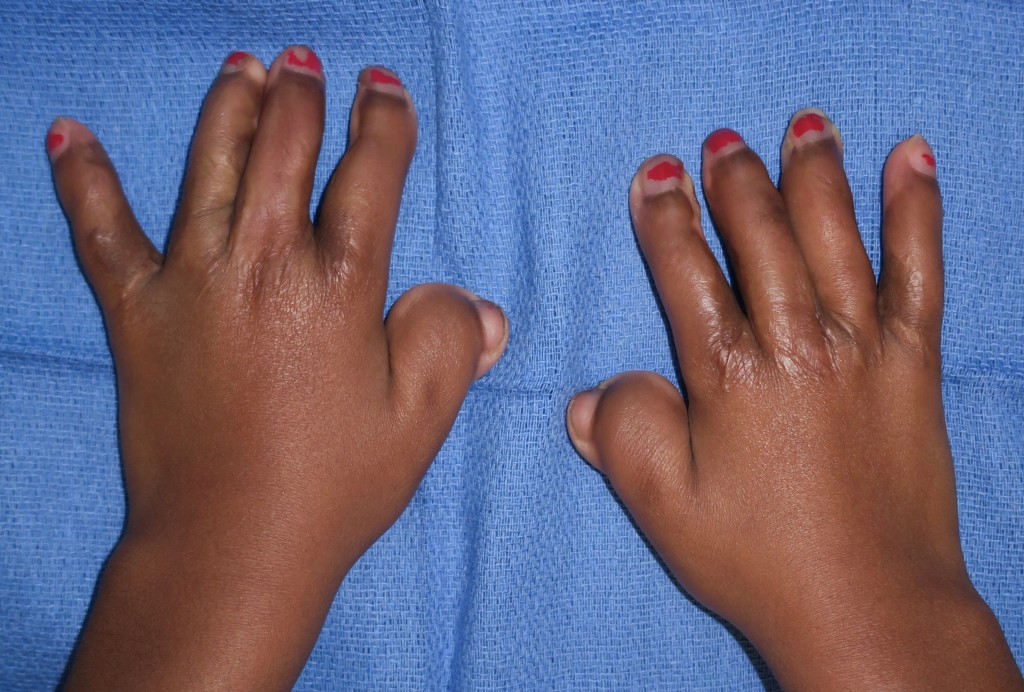
Hands of a child with Apert syndrome after separation of fingers.
Split thumb is when a child has two thumbs on one hand.
- Split thumb is also called duplicate thumb or “radial polydactyly”.
- The thumbs may be separate or appear fused, and they could be similar in size or quite different.
- One of the thumbs usually has better formed bones, muscles, and tendons and the potential to function better.
- Most commonly, split thumb occurs by itself, is only on one hand, and is not associated with other medical conditions.
- Surgery is usually performed around 1-2 years of age. Since the two thumbs share anatomical structures (such as muscles, tendons, ligaments, blood vessels, nerves, and bone), surgery is more complex than just removing one of the thumbs. In addition to removing one of the thumbs, surgery augments or reconstructs the thumb that remains. A pin might be temporarily placed to help hold the position of the bones during healing.
- Your child will likely be in a cast for about 5-6 weeks after surgery. Once the cast is removed, hand therapy will help your child start using their hand again. After cast removal, a removable thumb brace will be worn at nighttime for several more weeks. Even after surgery and therapy, the thumb that remains is a bit smaller and often moves differently compared to the thumb on your child’s other hand.

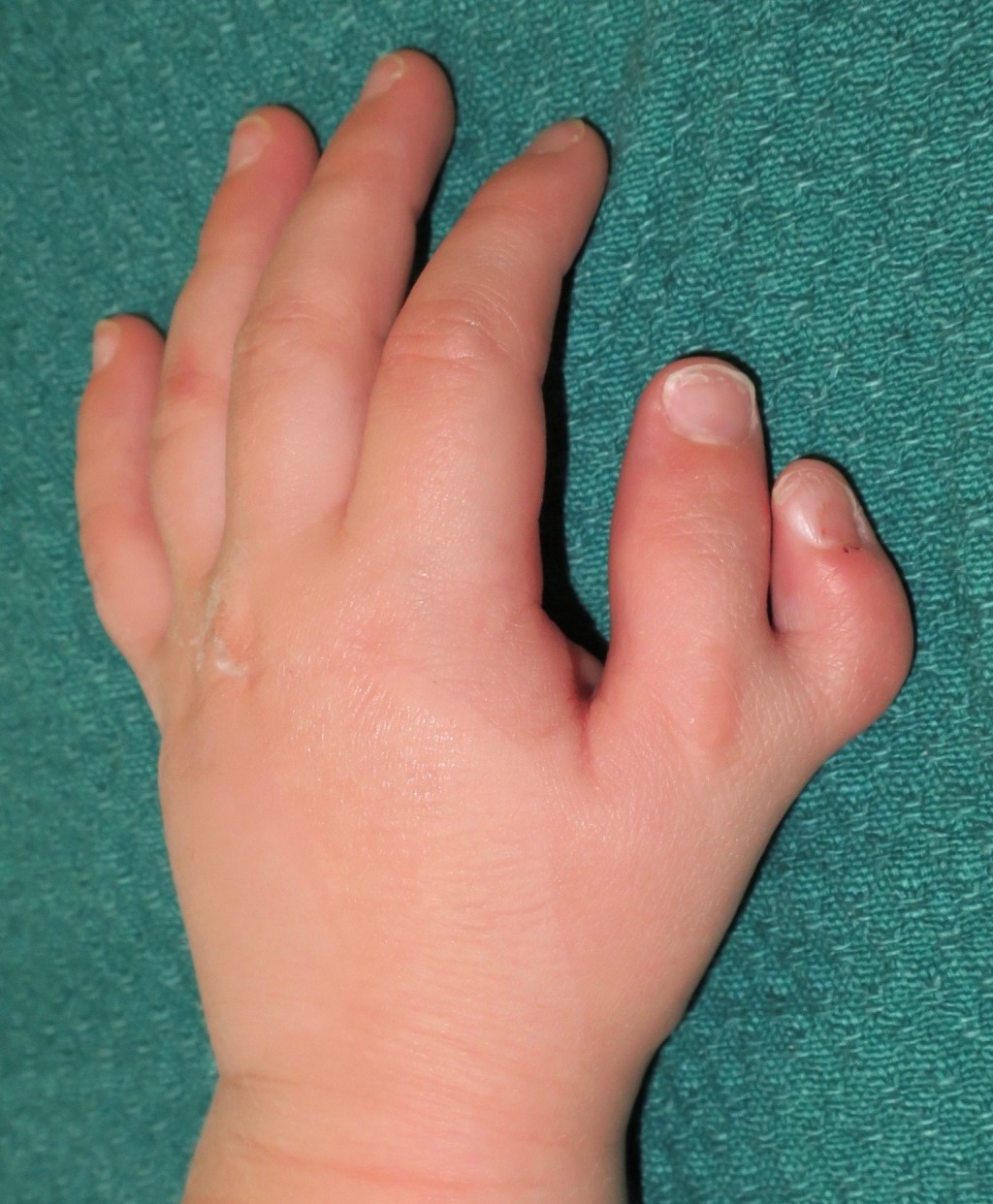
- Constriction ring sequence (sometimes called amniotic band syndrome) results when amniotic bands from the lining of the uterus entangle a child in the womb.
- Bands can wrap around any part of the body, and often more than one arm or leg is affected.
- The tightness of the bands can vary. Some bands are loose and just cause a shallow indentation. However, some bands are so tight that they strangle a body part and cause amputation. Bands can also cause webbing (syndactyly) of fingers and toes.
- Some children also have cleft lip and/or cleft palate or clubfoot.
- Constriction ring sequence is sometimes confused with another congenital hand condition called symbrachydactyly.
- Treatment varies for each child. Some shallow bands do not cause problems and do not require surgery. However, surgery can help if the band is deep or if it interferes with function. Timing of surgery and the number of surgeries varies based on your child’s specific needs.
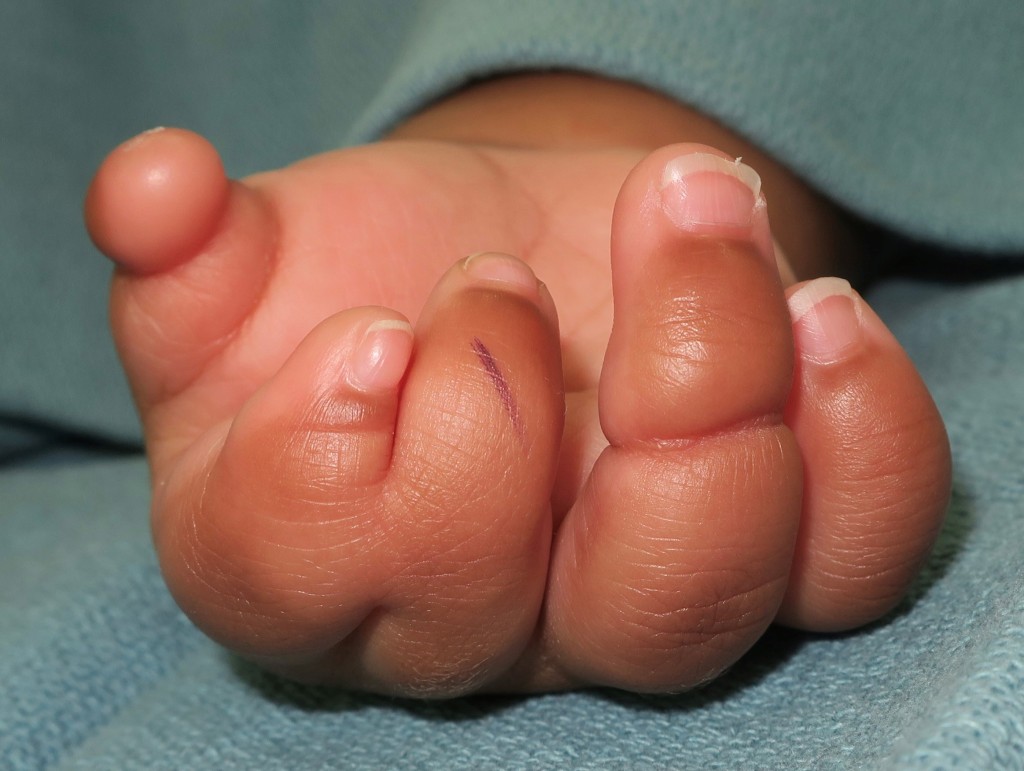
On this child’s hand, amniotic bands caused band-like indentations, syndactyly, and a thumb amputation.

- Symbrachydactyly means short, fused digits. Children with symbrachydactyly have underdevelopment of some or all the fingers on one hand.
- Symbrachydactyly can present in different ways. Sometimes all the fingers are present but small. Other times some of the fingers are very short and have absent bones and stiff knuckles. Sometimes there is webbing between the fingers. Occasionally some of the fingers are missing and appear as small skin tags. In more severe cases, the hand may be entirely absent and the whole arm a bit short.

Photograph showing the spectrum of symbrachydactyly.
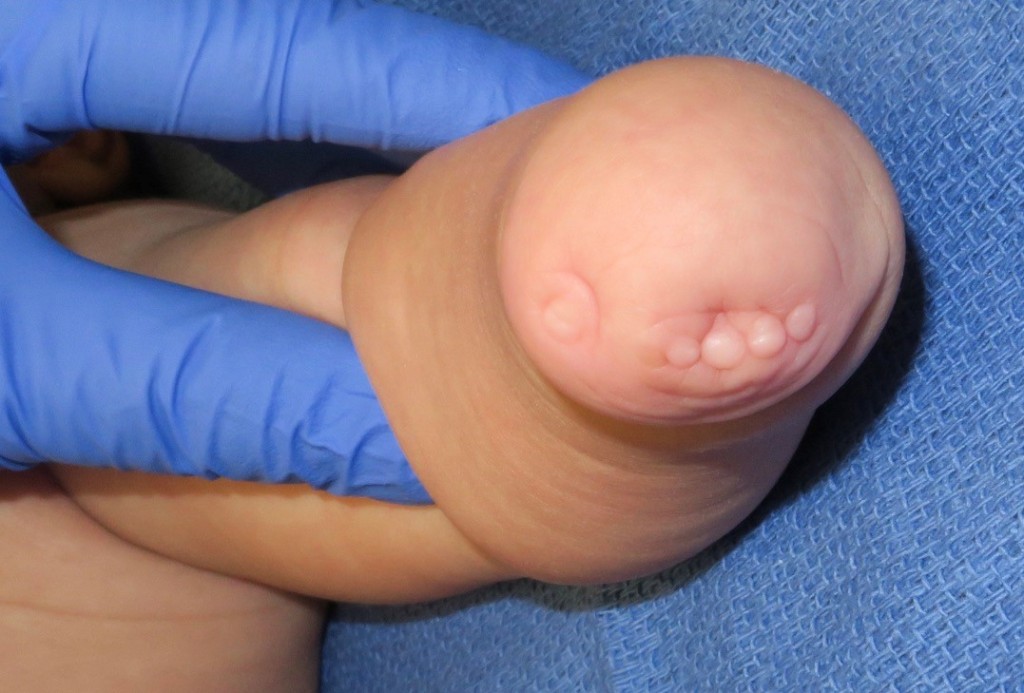
Photograph showing the spectrum of symbrachydactyly.
- It does not usually run in families, and it often occurs alone - without other conditions. The one exception to this is that some children with a particular type of symbrachydactyly might also have a condition called Poland sequence which affects growth of the chest muscle on the same side as the smaller hand.

A child with symbracydactyly of his right hand and Poland sequence affecting his right chest.
- Symbrachydactyly is often confused with another congenital hand condition called constriction ring sequence (also known as amniotic band syndrome). Your doctor will help determine which your child has.
- Treatment depends on how you child’s hand is affected. Many children with symbrachydactyly do great without surgery. However, sometimes surgery can help make certain tasks easier or help your child’s hand work or look differently. Some surgeries separate fingers and others add length to fingers. How your child uses his/her hand will change over time as he/she grows and develops, and your doctor will continue to follow your child along the way.
- Clinodactyly means curved finger. Most commonly, it affects the small finger so that it curves toward the ring finger. However, the thumb and other fingers can also have clinodactyly.
- Clinodactyly is caused by a growth plate in a bone that is growing unevenly.
- Clinodactyly can be on one hand or both hands. Sometimes it runs in the family or is part of a general medical condition or syndrome.
- Each bone in the finger has a growth plate. If one of the growth plates has a different shape, then the bone will have a shape which is more triangular than rectangular. The triangle-shaped bone causes finger to curve.
- The curve in the finger can change and become more obvious while your child’s growth plates are open.
- Treatment depends on the amount of curve and how old your child is. Surgery focuses on changing the shape of the bone and/or altering the growth plate. Most commonly, clinodactyly does not change the way your child uses his/her hand, and surgery is not recommended. However, sometimes surgery can help.

Clinodactyly of the small finger.
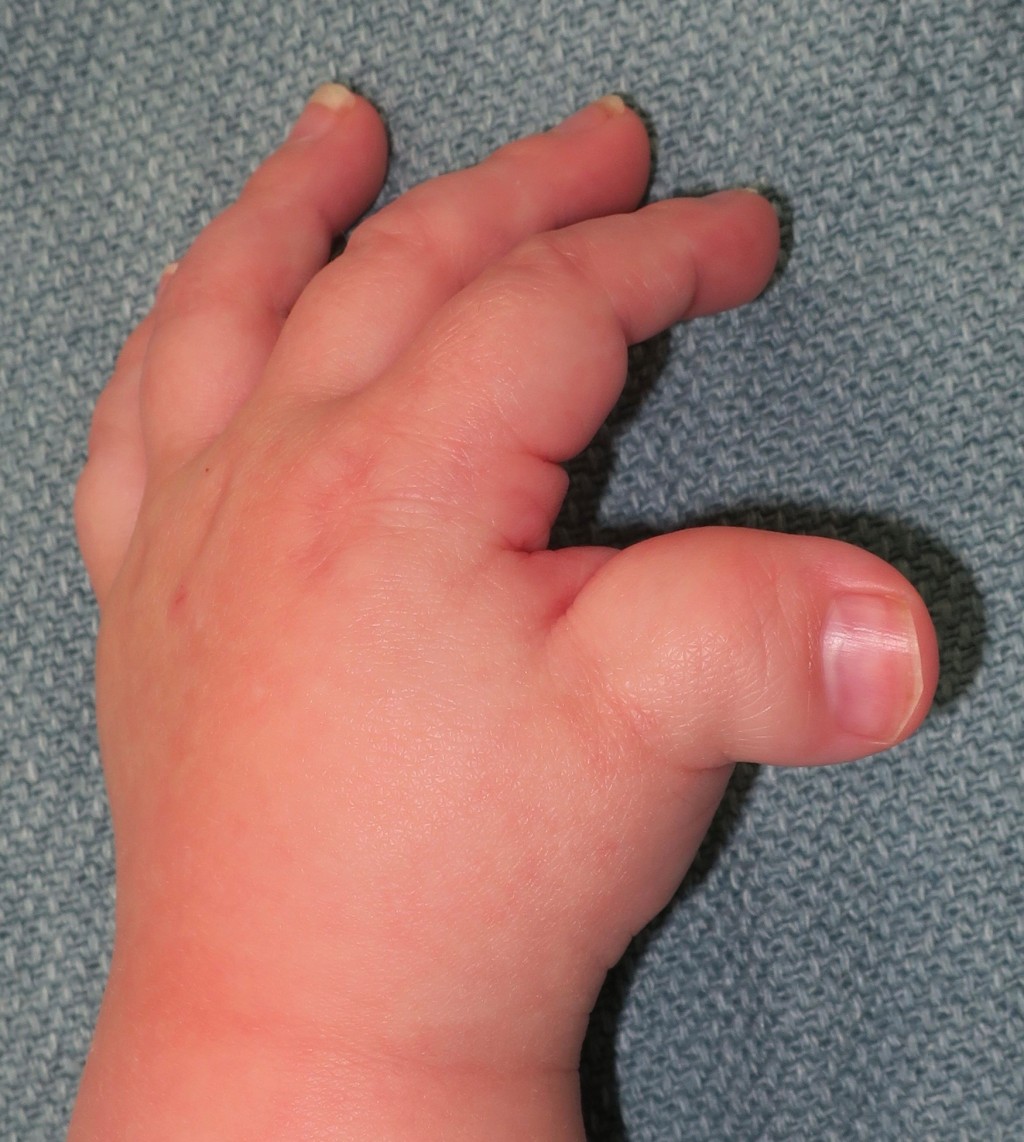
Clinodactyly of the thumb.
- Polydactyly means extra digit. The extra digit can be on the thumb side of the hand (radial polydactyly), in the middle of the hand (central polydactyly), or on the small finger side of the hand (ulnar polydactyly).
- The extra finger can be quite small and floppy or a fully developed, working finger.
- The extra finger is sometimes inherited or part of a more general medical condition, but usually there is no clear cause.
- Radial polydactyly is also known split thumb or duplicate thumb. See the section on split thumb / duplicate thumb for more information.
- Ulnar polydactyly (an extra finger on the small finger side) is the most common type of polydactyly. Usually there is a small extra finger connected by a thin bridge of skin. Other times there is a more completely formed extra digit with a connection to the hand that is strong and has bone in it.
- Surgery removes the extra digit, and timing depends on its size. Sometimes the extra digit can be removed in the newborn nursery or in the doctor’s office. However, there are times it is best to remove it in the operating room.

- Thumb hypoplasia (also called hypoplastic thumb) describes a thumb that is underdeveloped and small.
- The underdevelopment can range from a slightly small thumb to an absent thumb (known as thumb aplasia) and everything in between.
- In addition to the thumb, other fingers or arm bones might move and grow differently.
- Thumb hypoplasia can occur alone or as part of another condition such as radial longitudinal deficiency, ulnar longitudinal deficiency, central deficiency, or symbrachydactyly. It can also occur as part of a genetic syndrome (for example: VACTERL association (vertebral abnormalities, anal atresia, cardiac abnormalities, tracheoesophageal abnormalities, renal and radial abnormalities, limb differences), TAR (thrombocytopenia absent radius), Holt-Oram syndrome, and Fanconi anemia). It is important to determine if your child’s thumb hypoplasia or aplasia is part of one of these conditions.
- Our recommended treatment ultimately depends on how well your child uses his/her thumb. Sometimes surgery can help make a hypoplastic thumb sturdier and have better motion. However, in more severe cases a surgery which turns the index finger into a thumb might be a better option.
- Surgery is often performed around 2 years of age, but timing can vary based on your child’s specific needs. After surgery, your child will be in a cast while his/her hand heals. Once the cast is removed, therapy will help maximize use of the hand.

Thumb hypoplasia which is mild.

A child with an absent thumb.